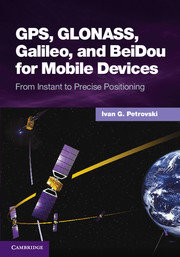Book contents
- Frontmatter
- Contents
- Foreword by Glen Gibbons
- About this book
- Acknowledgments
- List of abbreviations and acronyms
- List of definitions
- Part I GNSS: orbits, signals, and methods
- 1 GNSS ground and space segments
- 2 GPS, GLONASS, Galileo, and BeiDou signals
- 3 Standalone positioning with GNSS
- 4 Referenced positioning with GNSS
- Part II From conventional to software GNSS receivers and back
- Part III Mobile positioning at present and in the future
- Part IV Testing mobile devices
- Index
- References
2 - GPS, GLONASS, Galileo, and BeiDou signals
from Part I - GNSS: orbits, signals, and methods
Published online by Cambridge University Press: 05 May 2014
- Frontmatter
- Contents
- Foreword by Glen Gibbons
- About this book
- Acknowledgments
- List of abbreviations and acronyms
- List of definitions
- Part I GNSS: orbits, signals, and methods
- 1 GNSS ground and space segments
- 2 GPS, GLONASS, Galileo, and BeiDou signals
- 3 Standalone positioning with GNSS
- 4 Referenced positioning with GNSS
- Part II From conventional to software GNSS receivers and back
- Part III Mobile positioning at present and in the future
- Part IV Testing mobile devices
- Index
- References
Summary
A GNSS signal is transmitted from a satellite in order to measure the distance between the satellite and a receiver. There are four GNSS today: GPS, GLONASS, Galileo, and BeiDou. Each GNSS has its signal transmitted on specific radio frequencies. In this book we mainly consider single-frequency devices working with frequencies in the L1 band. The reasons for this are discussed in Chapter 10. The L1 signals for all current navigation satellite systems are shown in Table 2.1. Figure 2.1 shows how the signal frequency bands are distributed. The signals on these frequencies share some specific features, which we consider in this chapter. The frequencies for the GNSS L1 signal are slightly different, but this difference is not large enough to cause any variation in their error budget. For readers interested in the position of GNSS signals in the overall electromagnetic wave spectrum, the signal description from an electromagnetic theory point of view, and the fine aspects of signal propagation through the atmosphere, which may be derived from consideration of electromagnetic theory, such as signal scintillation theory and models, we recommend [1].
GNSS signals
The description of GNSS signals is given in the corresponding Interface Control Documents (ICD): for GPS L1/L2 in IS-GPS-200 [2], for GPS L1C in IS-GPS-800 [3], for GLONASS L1/L2 [4], for Galileo [5], and for BeiDou [6].
- Type
- Chapter
- Information
- GPS, GLONASS, Galileo, and BeiDou for Mobile DevicesFrom Instant to Precise Positioning, pp. 39 - 87Publisher: Cambridge University PressPrint publication year: 2014
References
- 3
- Cited by



